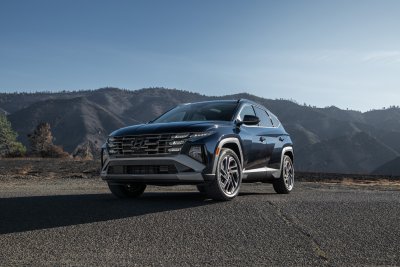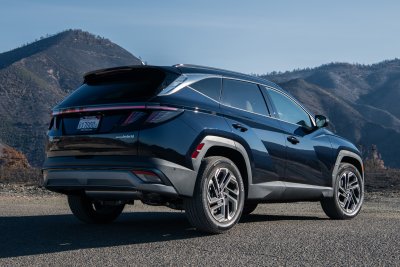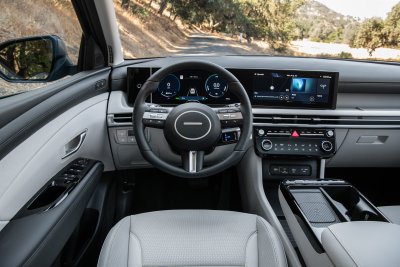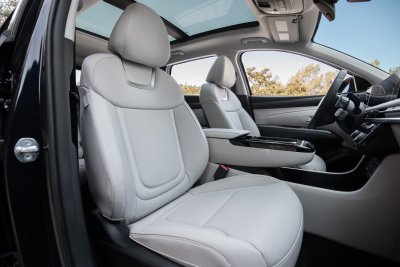Hyundai is in an excellent position on a global scale. The Motor Group, including Genesis and Kia, is now the third largest automaker in the world next to Toyota and Volkswagen. Its best-selling vehicle, the Hyundai Tucson, is now fifth on the compact SUV scorecard and rising behind the Toyota Rav4, Honda CR-V, Nissan Rogue and Chevrolet Equinox. When redesigning your bestseller, coming off its best sales year ever, it’s not time to swing for the fences, it’s time to push the team forward.
The 2025 Hyundai Tucson was updated with a more vertical, robust front end with redesigned headlights that still fade into the grille when unlit. It has a new stronger looking grille shield and an updated rear bumper to go along with new wheels choices and badges.
Hyundai says it’s constantly searching for new design solutions that will excite its customers, asking them how they use the vehicle and what issues they have. It also has three previous generations to look at when sketching the new one. With this Tucson, Hyundai says it took inspiration from a galloping stallion, “and was trying to capture a lot of that stored energy in vehicle form.”
Like many generational and midcycle updates, Hyundai put the call out to all its design houses across the world, picked the top few and then started adding production vehicle accoutrements like mirrors, wipers and door handles. Hyundai looked at drawings of the vehicle being used, camping, going to Ikea and in other situations to get a feel for how it would work for customers.
The previous Hyundai Tucson came with three powertrains including internal combustion, hybrid and a plug-in hybrid with 30 miles of all electric range. Those all remain including the 2.5-liter four-cylinder gasoline model delivering 187 horsepower (hp); the hybrid has a 1.6-liter four-cylinder with an electric motor delivering 231 hp and the plug-in hybrid makes 268 hp. Again, the company is not changing its game plan, sticking with what got it there in the first place.

Hyundai Motor America

Hyundai Motor America
The gasoline model is the least efficient returning 28 miles per gallon (mpg) while the hybrid and plug-in are both rated at 35 mpg combined. Both the hybrid and plug-in are only available with all-wheel drive, the ICE version can be powered by the front or all four wheels.
As expected, the 2025 Tucson has different drive programs for Eco, Smart, Sport and Snow, Smart being the mode that adapts to the driver. For 2025 it gets one more called Baby Mode, which is used when newborns and pets are in the vehicle. In practice it desensitizes the accelerator; takeoffs will be smoother and slower, as will passing maneuvers.
The hybrid tested here benefits from a few extra horsepower over last year, though it isn’t noticeable on the street. Its 231-hp, 271-pound-foot (lb-ft) powertrain is perfect for the Tucson’s compact size, which is almost exactly the same as the popular and competitive Toyota Rav4. Both hybrid models come with a six-speed automatic transmission, the standard Tucson gets an eight-speed automatic.
In Sport mode the Tucson Hybrid is quick enough to accelerate past most traffic. The small engine is quiet unless it really gets close to redline, which is rarely necessary. It does have paddle shifters mounted on the steering wheel; however, they only work normally in Smart, Snow and Sport modes, in Eco mode they adjust settings for the regenerative braking. The braking is light in both modes, though it does recharge the small battery. The hybrid doesn’t have an all-electric mode, but the upcoming plug-in hybrid will, along with that 30-mile range.
The single-setting suspension is comfortable and soft, softer than both the Toyota Rav4 and Honda CR-V, the steering effort, too, seems relaxed. The 2025 Tucson’s body is rarely upset over potholes, and the cabin is quiet even over rougher roads.

Hyundai Motor America

Hyundai Motor America
Moving into the cabin, the new Tucson gets upgrades to the infotainment system, which is now two screens together, the center of which is a 12.3-inch touchscreen. There’s a new upper dash tray for either the passenger or driver to store phones, wallets and other things. The center console is new as are the ambient lights, which can be colored to the driver’s mood. It’s also the only vehicle currently in the segment with a head-up display.
The cabin is one of the most ergonomic on the road with physical knobs for climate, volume and radio tuning. It also has permanent mode buttons that make switching between wireless Apple CarPlay, Android Auto and the native functions. Drivers can still use the navigation from the phone and listen to satellite radio at the same time. Both front and rear passengers have access USB-c ports; the front can also transfer data, however, wireless charging is also available. Hyundai’s Digital Key 2 is also optional for the Tucson, which allows for door locking, unlocking and vehicle engine start without needing to take your phone out of your pocket.
Heated and cooled seats are available, standard on the hybrid, but all are comfortable in all rows. It has more interior space than its main competitors, with about 40 cubic feet with the seats in place and nearly 80 when the second row is folded. Stacked to the ceiling, there is plenty of room for a cooler, a few sleeping bags, backpacks and other gear one might need for a weekend at the cottage.
For 2025, Tucson adds Forward Attention Warning (FAW) to monitor the attention levels of the driver. Available Smart Cruise Control 2 assesses driver alertness and brings the vehicle to a stop if they are unresponsive. As standard the 2025 Hyundai Tucson comes with the company’s Smart Sense safety features including emergency braking, forward collision warning, lane keeping, blind spot warning, adaptive cruise control and a few others. Those standard options are now common, and possibly required to be in the conversation, and shared with both the Honda CR-V and Toyota Rav4.
There are more than a dozen trims of the 2025 Hyundai Tucson, which starts at $28,355, not including destination and handling. The Tucson Hybrid starts at $33,115 and the Plug-in Hybrid is $39,380, remembering that both hybrids come standard with all-wheel drive. The 2025 Honda CR-V starts at $30,100 and the Rav4 comes in at $28,475 and tops our around $40,000, same as the Tucson and Honda.
The compact SUV segment, in which the Tucson bats, is the most competitive and biggest part of the market, accounting for almost 18 percent. And when you’re playing in that game with Honda’s Babe Ruth in the CR-V and Toyota’s Hank Aaron Rav4, you just need to put batters on base, or drivers in seats. Hyundai has done that with the current generation of Tucson, which is now just a little bit better in every metric with this update.
👇Follow more 👇
👉 bdphone.com
👉 ultraactivation.com
👉 trainingreferral.com
👉 shaplafood.com
👉 bangladeshi.help
👉 www.forexdhaka.com
👉 uncommunication.com
👉 ultra-sim.com
👉 forexdhaka.com
👉 ultrafxfund.com
👉 ultractivation.com
👉 bdphoneonline.com




